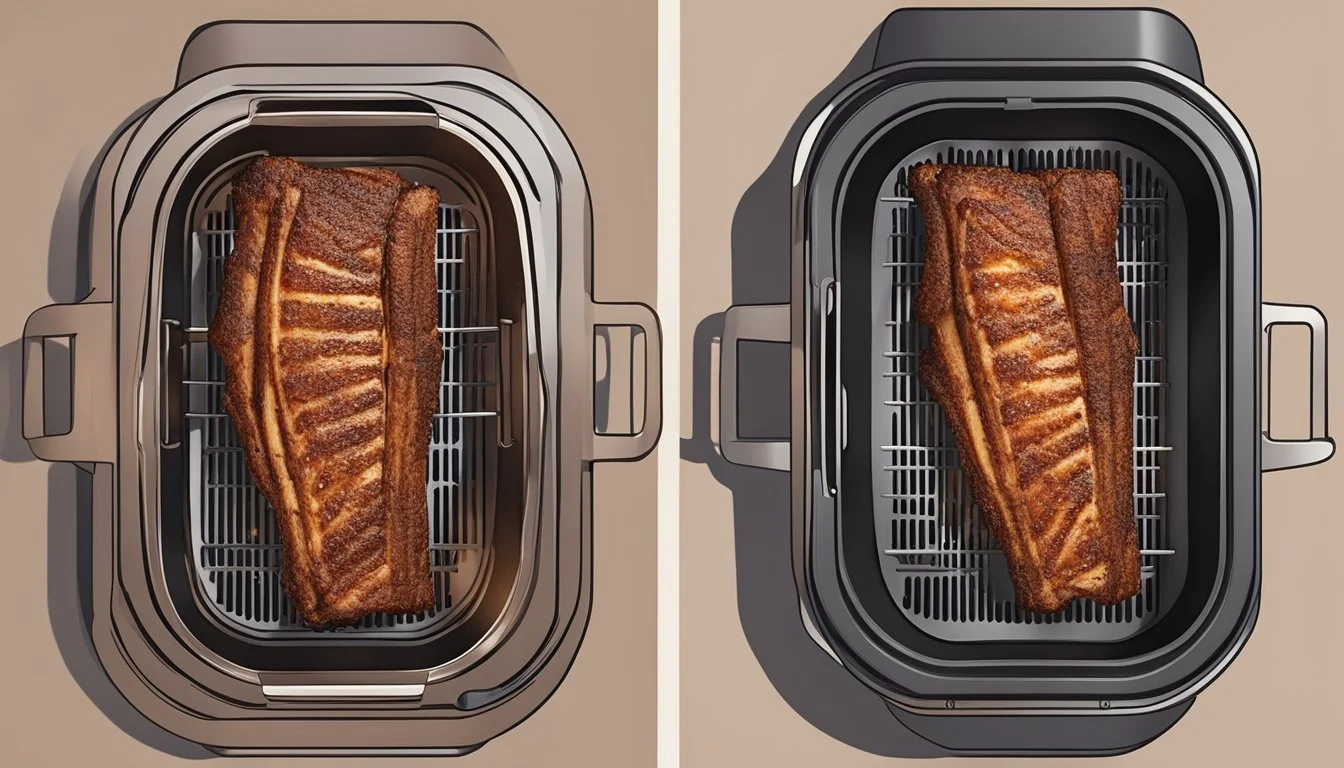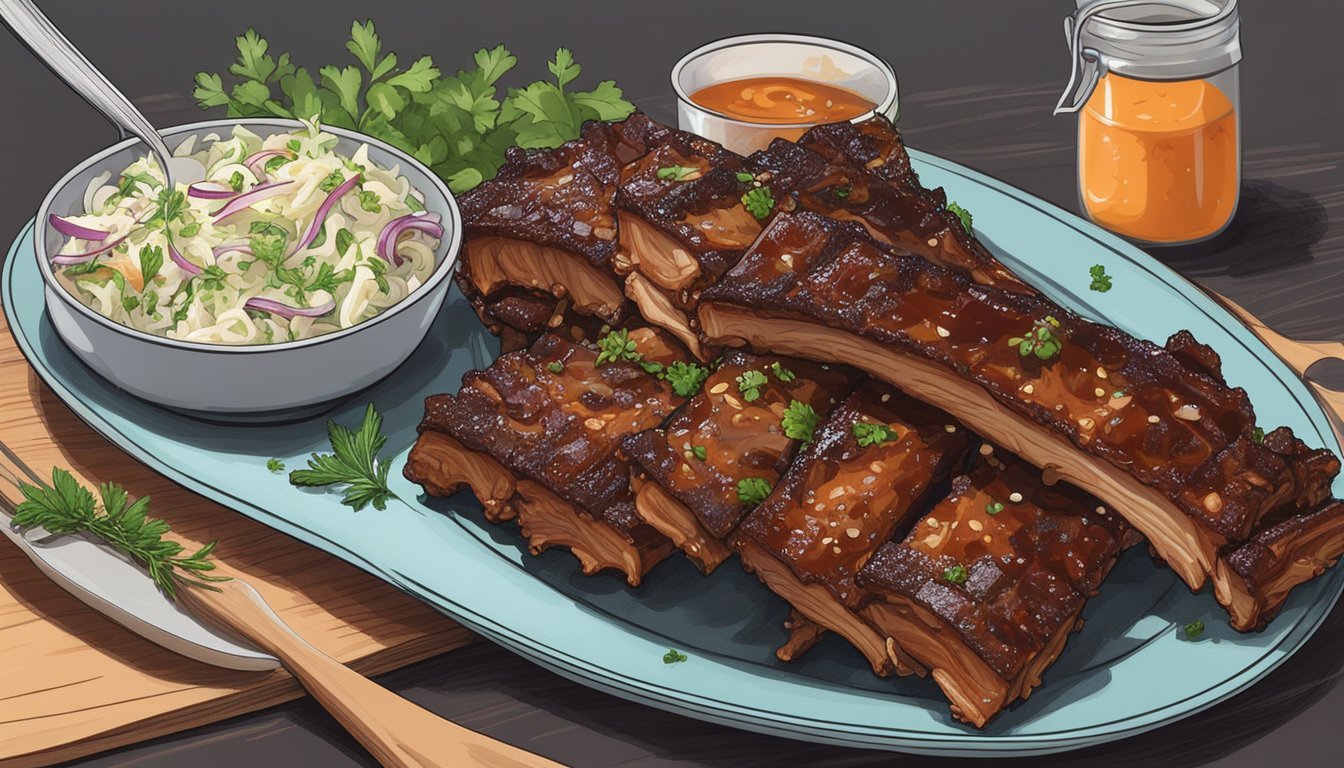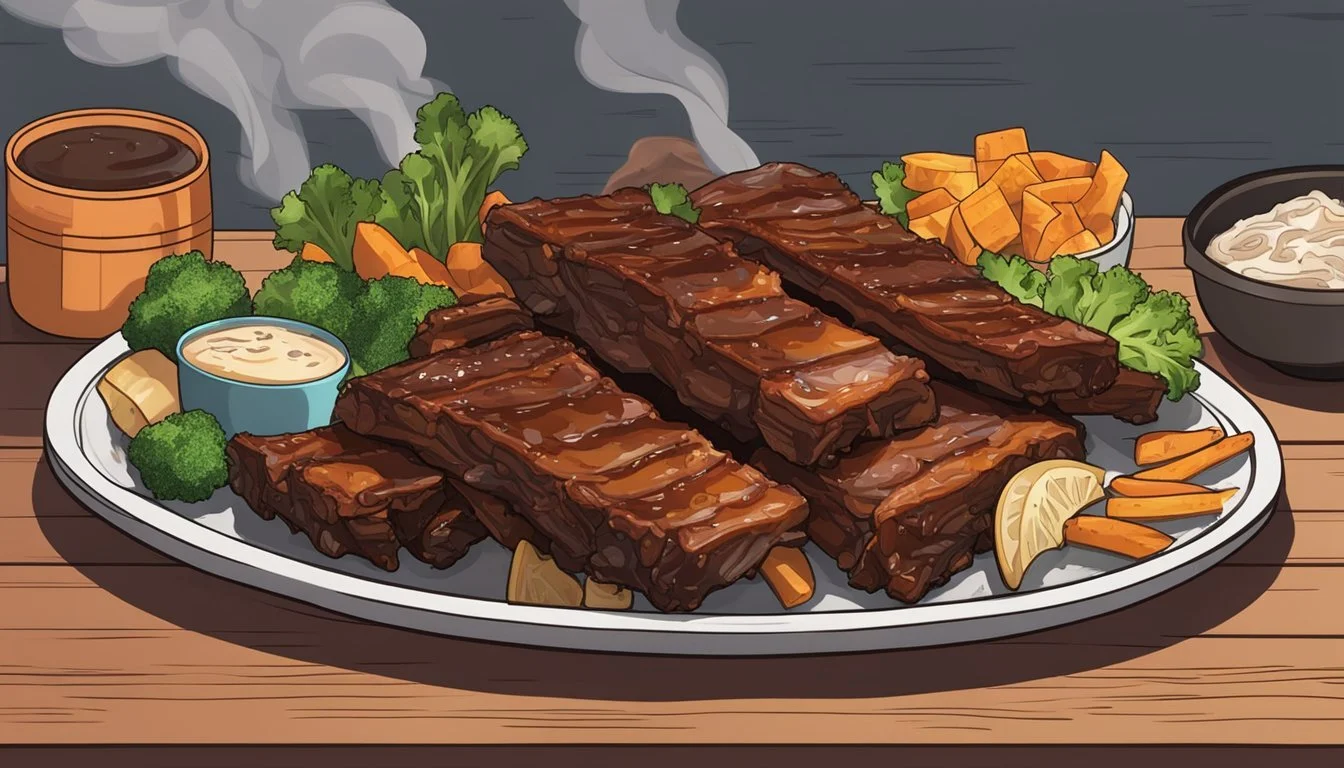Air Fryer BBQ Ribs
Effortless Indoor Smoking Flavors
Air fryer technology has revolutionized home cooking, presenting a way to enjoy the flavors of traditionally grilled foods with a fraction of the effort and mess. Among these easy-to-make dishes, BBQ ribs have gained popularity for their juicy and tender texture that can be achieved without a grill. The air fryer circulates hot air around the ribs, cooking them evenly and creating a delectable exterior that's reminiscent of the smoky goodness of outdoor barbecuing.
The convenience of using an air fryer means BBQ rib enthusiasts can prepare their favorite meal in any climate, regardless of outdoor conditions. The key steps involve removing the membrane for tenderness, seasoning the ribs with a well-balanced rub, and cooking them at the right temperature to ensure the meat falls off the bone. The sauce applied towards the end of cooking caramelizes beautifully, adding that classic BBQ finish.
These ribs are not confined to the long, smoky process of traditional barbecuing methods, yet they do not compromise on taste or texture. Home cooks can achieve that succulent, smoky flavor in a kitchen appliance that is becoming a staple in homes worldwide, making the air fryer a versatile tool for both novices and experienced cooks alike.
Selecting the Perfect Ribs
When it comes to preparing BBQ ribs in an air fryer, selecting the right type of meat is as crucial as the cooking process itself. This section provides a guide on the different types of ribs available and what to look for when choosing quality meat for air frying.
Types of Ribs
There are two primary types of pork ribs (What wine goes well with pork ribs?) that are popular for air frying:
Baby Back Ribs: These ribs come from the top of the rib cage between the spine and the spare ribs, below the loin muscle. They are shorter, curved, and typically leaner and tender. A full rack of baby back ribs usually includes 10-13 bones and weighs around 1.5 to 2 pounds.
Spare Ribs: Located on the belly side of the rib cage, these are flatter and larger than baby back ribs. Spare ribs contain more bone and fat, making them juicier when cooked right. A full rack of spare ribs is typically heavier, weighing between 2 to 4 pounds.
Although less common in air fryer recipes due to their size, Beef Short Ribs (What wine goes well with beef short ribs?) can also be used. They are much larger and require a longer cooking time to become tender.
Meat Quality and Selection
Selecting ribs isn't just about the type; it’s also about the quality. Here’s what one should look for:
Meat Coverage: Choose ribs that have a lot of meat on top of the bones and less visible fat. There should be a good meat-to-bone ratio for the best eating experience.
Marbling: Look for ribs with good marbling, which are the fine threads of fat running through the meat. This marbling is crucial as it melts during cooking, keeping the meat moist and adding flavor.
Color and Smell: Fresh pork ribs should have a pinkish-red color with no off-odors. The meat should be firm to the touch and moist but not wet or slimy.
When selecting a rack of ribs, one should always check that it will fit into their air fryer basket. Baby back ribs might fit more easily due to their size, while spare ribs may need to be cut into smaller sections.
Air Fryer Basics
When cooking with an air fryer, individuals often discover the method to be a quick and easy alternative to traditional grilling or baking. The air fryer operates by circulating hot air around food, providing a consistent cooking temperature and a method that often results in less oil usage than conventional frying.
Advantages of Using an Air Fryer
Healthier Cooking: By using significantly less oil than deep frying, an air fryer can reduce the overall fat content of dishes.
Efficiency: Air fryers typically cook food faster than ovens due to their compact size and the rapid hot air circulation method.
Versatile Kitchen Appliance: It can be used for a variety of recipes, from meats to vegetables and even desserts.
Convenient Cleaning: Most air fryers come with non-stick, dishwasher-safe parts, making for easy cleanup.
Preparing the Air Fryer for Cooking
Preheat the Air Fryer: Just like a conventional oven, it is crucial to preheat the air fryer to ensure a consistent cooking environment. The typical preheating temperature is around 380°F to 400°F, depending on the recipe.
Spaces for Air Circulation: When placing the food in the basket, ensure that there is enough space for air to circulate around the food to achieve an even cook.
Seasoning Your Ribs
Proper seasoning is essential for creating a mouthwatering rack of ribs in an air fryer. A balanced dry rub infuses the meat with flavor, while marinades can tenderize and add a different flavor profile.
Dry Rub Creation
To create a savory dry rub, one must combine a selection of ground spices that can include salt, black pepper, garlic powder, onion powder, paprika, and cayenne pepper. A touch of sugar can balance the heat and aid in caramelization. Here's a simple blend one might use:
2 tablespoons brown sugar
1 tablespoon paprika
2 teaspoons salt
1 teaspoon black pepper
1 teaspoon garlic powder
1 teaspoon onion powder
1/2 teaspoon cayenne pepper
Mix these ingredients evenly to ensure consistent flavor throughout the meat.
Applying the Dry Rub
Before applying the dry rub, one should always remove the membrane from the ribs to allow the spices to penetrate thoroughly. Pat the ribs dry and generously coat all sides with the rub mixture, pressing it into the meat to adhere. Ideally, let the ribs sit with the rub on them for at least 15 minutes to absorb the flavors.
Marinade Options
While a dry rub offers intense flavor, a marinade can provide a different dimension and help tenderize the ribs. A basic marinade might feature ingredients such as Worcestershire sauce for umami, garlic powder for zest, and salt for seasoning. A sample marinade ratio could be:
1/4 cup Worcestershire sauce
2 tablespoons apple cider vinegar
1 tablespoon olive oil
1 teaspoon garlic powder
1/2 teaspoon salt
1/2 teaspoon black pepper
Combine these ingredients and immerse the ribs in the mixture, then cover and refrigerate for at least one hour, or overnight for deeper flavor infusion.
Cooking Process
The cooking process for Air Fryer BBQ Ribs involves three main steps: preparing the ribs, air frying to the perfect tenderness and juiciness, and resting them to enhance the flavors.
Pre-Cooking Preparation
Before cooking, it's important to remove the membrane from the back of the ribs to ensure they are tender. The cook can use a paper towel for better grip when stripping off the membrane. Next, the rack should be cut into sections that fit into the air fryer basket. Ribs should be patted dry and seasoned with a favorite spice rub or BBQ sauce for additional flavor.
Air Frying Technique
To begin, preheat the air fryer to a temperature around 375°F (190°C). When ready, place the seasoned ribs into the fryer basket without overcrowding, which could affect cooking times and results. Depending on the air fryer's size, the ribs may need to be cooked in batches. Wrap the ribs in foil for air frying to maintain moisture – this ensures juicy ribs. Cook time will vary, but typically ribs will need 20-30 minutes. The ribs are done when the internal temperature reaches 145°F, which is the safe minimum for pork.
Post-Cooking Rest
After cooking, it’s crucial to let the ribs rest for a few minutes, as this allows the juices to redistribute. The rest can promote tenderness, making the ribs not just perfectly cooked but also deliciously succulent. A rest period of about 5-10 minutes is usually sufficient before serving.
BBQ Sauce and Glazing
The right BBQ sauce can transform air fryer ribs from simple to exceptional. Glazing with the sauce at the optimal time imparts a smoky, caramelized coat that's both visually appealing and delicious.
Choosing a BBQ Sauce
When selecting a BBQ sauce for air fryer ribs, one should consider both flavor profile and consistency. Options range from store-bought varieties to homemade concoctions. A thick sauce is preferable as it clings better during the glazing process, ensuring robust flavor.
Store-Bought: Choose sauces labeled as "thick" or "sticky", with a preference for those with natural ingredients and less preservatives.
Homemade BBQ Sauce: A simple recipe might include ketchup, brown sugar, vinegar, and various spices. Customizing the sauce allows for adjustment of sweetness, tanginess, and smokiness to personal taste.
Applying the Sauce
Timing is essential when it comes to applying BBQ sauce to air fryer ribs. Sauce should be applied during the final minutes of cooking to prevent burning and to achieve a sticky glaze.
Initial Cook: Ribs should first be cooked until nearly done before any sauce is added.
Glazing: Generously brush the ribs with a layer of sauce on all sides, then return them to the air fryer for a few additional minutes—just long enough to allow the sauce to caramelize slightly. A common approach is to air fry the sauced ribs at 350°F for around 3 minutes.
By following these steps, the ribs are given a glossy, flavorful exterior that complements the tender meat.
Side Dishes and Pairings
The right side dishes can elevate air fryer BBQ ribs from a simple meal to a full, satisfying dining experience. Below are pairings that range from traditional to more inventive, sure to complement the smoky goodness of the ribs.
Classic Accompaniments
Corn on the cob: Grilling isn’t needed to achieve that perfect summer flavor. Air fryer corn on the cob retains a sweet, juicy bite and can be made in minutes, seasoned with butter, salt, and a sprinkle of chili powder.
Coleslaw: The creamy, tangy profile of coleslaw offers a refreshing contrast to the rich ribs. It adds a crunchy texture that balances the softness of the meat.
Potato Salad: A hearty potato salad provides a flavorful and cooling complement. Its creamy dressing and soft potatoes work well alongside the tender ribs.
Cornbread: Sweet and savory cornbread serves as the ideal sponge for any extra BBQ sauce on the plate.
Innovative Combinations
Air Fryer Vegetable Medley: Consider throwing in bell peppers, zucchini, and onions into the air fryer to create a slightly charred, roasted vegetable medley.
Zesty Quinoa Salad: A light quinoa salad with lime, corn kernels, and fresh cilantro can add a refreshing zest to the smoky flavor profile of the ribs.
Each side dish not only pairs wonderfully with the BBQ ribs but also brings its own unique flavors and textures to the table, elevating the overall feast.
Nutritional Information
When preparing BBQ ribs in an air fryer, one can enjoy the flavors of traditional barbecue without the need for a grill. However, it's important to consider the nutritional aspects of this beloved dish. Ribs are, by nature, a richer meat choice, often associated with higher caloric content due to their fat content.
Caloric content: A typical serving of air fryer BBQ ribs, which is about 3 to 4 ounces of meat, contains roughly 200 to 300 calories. The exact number may vary based on the cut of the ribs and the ingredients used in the marinade or rub.
Protein: Ribs are a substantial source of protein. The same serving offers about 20 to 25 grams of protein, contributing to muscle repair and growth.
Carbohydrates: Although the ribs themselves are low in carbohydrates, the BBQ sauce often contributes sugars, increasing the carbohydrate count. One can expect a serving of BBQ ribs to include approximately 5 to 15 grams of carbohydrates largely due to the sauce.
Nutritional breakdown:
Fat: Ribs are higher in fat, which contributes to both the taste and texture of the meat. A serving can contain 15 to 20 grams of fat, though methods like air frying can help reduce fat content compared to traditional grilling.
Sugars: The barbecue sauce used can add additional sugars to the meal. When preparing ribs, consider the sugar content listed on the sauce's nutritional label.
It's worth noting that nutritional content can be adjusted by the choice of rubs and sauces, and by removing the membrane or trimming excess fat from the ribs before cooking. For a healthier alternative, individuals can opt for sugar-free BBQ sauces and leaner cuts of pork.
In summary, while air fryer ribs provide a protein-rich meal, attention should be paid to the fat, sugar, and overall caloric intake. Portion control and careful selection of ingredients can help in maintaining a balanced diet.
Storage and Leftovers
Properly storing and reheating Air Fryer BBQ Ribs ensures that the flavors and textures are nearly as delightful as when they were first cooked.
Airtight Storage Methods
Leftover ribs should be stored in an airtight container or tightly wrapped in heavy-duty aluminum foil or plastic wrap to maintain quality and prevent them from drying out. For best results, one should place the leftover ribs in the refrigerator if they plan to consume them within four days. If they need to be kept longer, the freezer is the best option, allowing the ribs to be preserved for up to three months.
Refrigerator:
Ribs should be placed in the refrigerator within two hours of cooking to prevent bacterial growth.
They need to be stored at or below 40°F (4°C).
Freezer:
For freezing, it's imperative to ensure that ribs are wrapped tightly to prevent freezer burn.
Clearly label with the date to keep track of how long they've been stored.
Reheating for Best Quality
Reheating leftover ribs requires attention to detail to restore the succulent texture and rich flavors. The ideal methods for reheating are using an oven, a microwave, or an air fryer. They should be heated to an internal temperature of 145°F (63°C).
Oven:
Preheat oven to 350°F (175°C).
Place the ribs in a baking dish with a small amount of liquid to help maintain moisture.
Cover with foil and bake until they reach the desired temperature, typically for about 10-15 minutes.
Microwave:
Place the ribs on a microwave-safe dish.
Cover with a damp paper towel to keep them moist.
Heat on medium power in 30-second intervals, checking for warmth.
Air Fryer:
Preheat the air fryer to 350°F (175°C).
Arrange the ribs in a single layer for even heating.
Heat for about 3-4 minutes or until heated through.
Each method has its own benefit, with the oven and air fryer providing a more evenly reheated rib and the microwave offering quickness and convenience.
Conclusion
Preparing ribs in an air fryer offers a convenient and efficient way to achieve that smoky barbecue flavor from the comfort of one's kitchen. This method has proven to be an excellent alternative to traditional grilling, presenting a dish that is both delectable and a family favorite.
Final Thoughts on Air Fryer BBQ Ribs
Air fryer ribs emerge as a standout main course, combining the ease of indoor cooking with the classic taste of outdoor barbecue. Their juicy, fall-off-the-bone texture and rich, smoky flavor can satisfy even the most discerning palates. It's no wonder this technique has become popular among home cooks seeking to serve a delicious meal with a gourmet touch.
Appendix
This section is dedicated to enhancing your culinary experience with air fryer BBQ ribs by providing practical advice and creative adaptations to the standard recipe.
Additional Tips and Tricks
When preparing BBQ ribs in an air fryer, it is essential to note that total cooking time may vary depending on the type of ribs (beef ribs or pork baby back ribs) and individual air fryer models. Prep time typically includes removing the membrane from the ribs with a sharp knife and applying the seasoning. To ensure meat is cooked through safely, one should use a meat thermometer; pork ribs are done when the internal temperature reaches 145 degrees Fahrenheit, while beef ribs should be cooked to 190-203 degrees Fahrenheit for that tender, fall-apart texture. To maintain the ribs' moisture, wrapping them in aluminum foil or parchment paper with a bit of honey can mimic traditional smoker methods. Lastly, cooking ribs in batches may prove necessary to avoid overcrowding and to achieve a crispy exterior.
Rib Type Ideal Internal Temperature Pork Baby Back Ribs 145°F Beef Ribs 190-203°F
Recipe Variations
An easy recipe for air fryer ribs allows room for personalization. For those keen on a different protein, pork chops can be a substitute for ribs and can benefit from the same smoky BBQ inspired rubs. For seasoning, swapping smoked paprika for a touch of chili powder adds heat, or incorporating more brown sugar can enhance sweetness. The adventurous cook may want to explore using teriyaki or a honey-garlic glaze to depart from the traditional BBQ profiles. Those looking for inspiration can browse Pinterest for unique rubs and sauce combinations. When venturing into variations, remember that different meats and coatings may affect cooking times, so adjustments may need to be made accordingly.
Ingredient Variation Ideas Paprika Substitute with chili powder Brown Sugar Increase for sweetness BBQ Sauce Try teriyaki or honey-garlic





